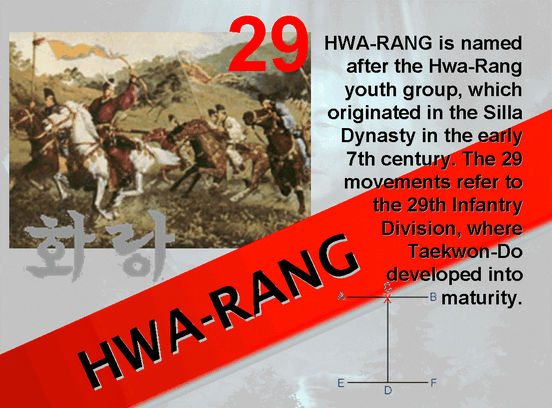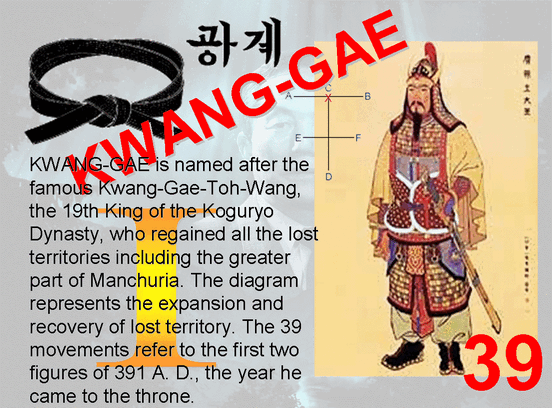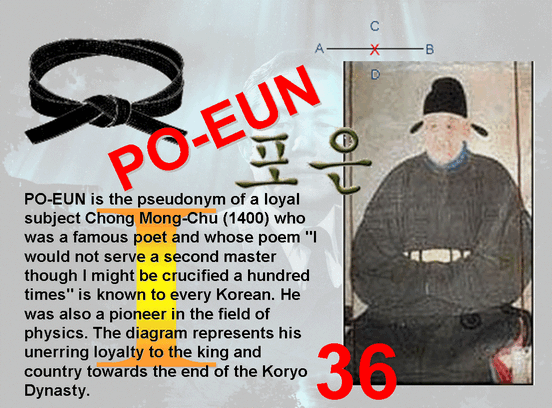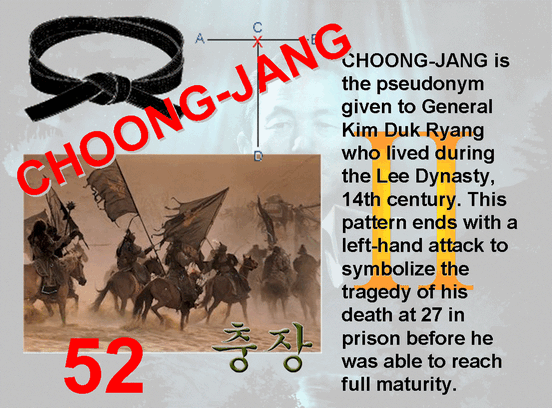Patterns
- Details
- Hits: 16065


























TYPES OF MOTION
NORMAL MOTION (POTONGURO)
The techniques are performed at normal speed with a pause long enough to show when one move has finished and the next is about to begin. There is one sine wave motion and one breath control for each technique.
CONTINUOUS MOTION (IOJIN TONGJAK)
This is performed as usual with the exception that there is no pause between the end of one movement and the start of the next. You should have one breath control for each technique, but without a pause. Continuous motion always starts with a block. The main reason for using this kind of motion is to allow an instant response to the attack, by either blocking the next technique or issuing your own counter.
CONNECTING MOTION (YON GYOL TONGJAK)
This is performed as usual with the following exceptions: There is no pause between techniques, there is only one breath control and one sine wave motion, it is usually impossible to determine where one technique ends and the next begins. Connecting motion is always with two movements using opposite arms. One reason for using this kind of motion is where one technique ‘sets up’ the opponent for an immediate attack.
FAST MOTION (BALLI)
There is a split second pause between the end of one movement and the start of the next. The sine wave is performed as usual for the first movement but the second movement has less initial downward motion to save time. You should breath normally and have one breath for each technique.
SLOW MOTION (CHONCHONHI)
This is performed with one sine wave and one breath control but is performed in slow motion. Unlike continuous, connecting and fast motion, this motion can be for one technique on its own. The reason for this type of motion is to develop balance, breath control and timing.
Reason for Patterns
Pattern practice enables the student to go through many fundamental movements in series, to develop sparring techniques, improve flexibility of movements, master body shifting, build muscles and breath control, develop fluid and smooth motions, and gain rhythmical movements.
It also enables a student to acquire certain special techniques which cannot be obtained from either fundamental exercises or sparring. In short, a pattern can be compared with a unit tactic or a word, if fundamental movement is an individual soldier’s training or alphabet. Accordingly, pattern, the ledger of every movement, is a series of sparring, power, feats and characteristic beauty.
Though sparring may merely indicate that an opponent is more or less advanced, patterns are a more critical barometer in evaluating an individual’s technique.
Important Points While Performing Patterns
- Pattern should begin and end at exactly the same spot. This will indicate the performer’s accuracy. 2.Correct posture and facing must be maintained at all times.
- Muscles of the body should be either tensed or relaxed at the proper critical moments in the exercise.
- The exercise should be performed in a rhythmic movement with an absence of stiffness.
- Movement should be accelerated or decelerated according to the instructions in this book.
- Each pattern should be perfected before moving to the next.
- Students should know the purpose of each movement.
- Students should perform each movement with realism.
- Attack and defense techniques should be equally distributed among right and left hands and feet.
Reason for 24 Patterns
There are a total of twenty-four patterns in Taekwon-Do.
The life of a human being, perhaps 100 years, can be considered as a day when compared with eternity. Therefore, we mortals are no more than simple travelers who pass by the eternal years of an eon in a day.
It is evident that no one can live more than a limited amount of time. Nevertheless, most people foolishly enslave themselves to materialism as if they could live for thousands of years. And some people strive to bequeath a good spiritual legacy for coming generations, in this way, gaining immortality. Obviously, the spirit is perpetual while material is not. Therefore, what we can do to leave behind something for the welfare of mankind is, perhaps, the most important thing in our lives.
Here I leave Taekwon-Do for mankind as a trace of man of the late 20th century.
The 24 patterns represent 24 hours, one day, or all my life.


